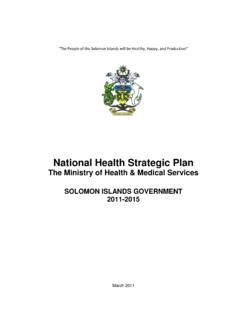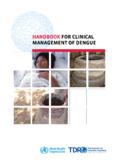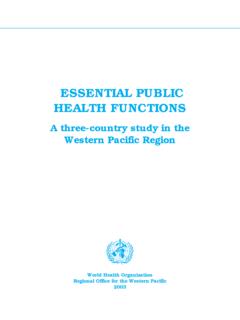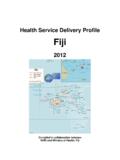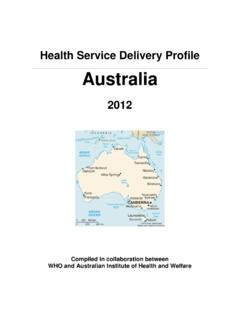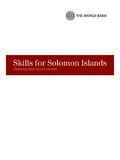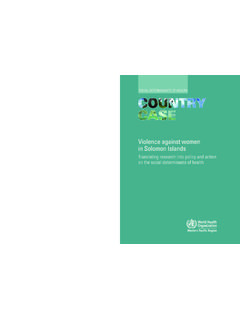Transcription of Health Service Delivery Profile Solomon Islands
1 Health Service Delivery Profile Solomon Islands 2012 Developed in collaboration between WHO and the Ministry of Health , Solomon Islands Health Service Delivery Profile , Solomon Islands , 2012 1 Solomon Islands Health Service Delivery Profile Demographics and Health situation Situated in the South Pacific Ocean, Solomon Islands is a diverse country with more than 900 Islands and 70 language Its capital, Honiara, is situated in the main province of Guadalcanal, and there are eight other provinces (see Annex 1). Like many other small island countries in the Pacific, parts of the Solomon Islands are at risk due to rising tides and sea levels.
2 At the time of the 2009 Census, the population was 515,870 and estimated to be growing at per The median age in 2009 was years, with 54% of the population aged 15-59 years and only 5% aged 60 or Its Human Development Index ( ) places Solomon Islands 142 out of 187 countries, showing an overall low level of development (based on Health , education and income).4 Urbanisation in Solomon Islands is 20%, and increasing at more than twice the overall rate of population Government thus faces the twin challenges of continuing to Service largely dispersed and often remote communities, while also striving to respond to the pressure of urban growth.
3 Access to improved sanitation is very low (18%) with a huge urban to rural difference (77% versus 5%).5 Public Health priorities include rural water supply, improving Health centres, and addressing tuberculosis, malaria, HIV/AIDS and sexually transmitted infections and common childhood Table 1 Key development indicators, Solomon Islands Indicator Measure Year Human development index 2011 Adult literacy rate (%) 2007 Total Health expenditure (% of GDP) 2009 Proportion of people living below national poverty line (%) 2010 Life expectancy at birth (years) 2009 Crude birth rate (per 1,000 population) 2009 Crude death rate (per 1,000 population) 2009 Infant mortality rate (per 1,000 live births) 2007 Maternal mortality rate (per 100,000 live births)
4 2008 Sources: WHO 2010;1 Mishra, Hargreaves & Moretto 20107 Like many developing countries, the Solomon s is undergoing an epidemiological transition and now faces a double burden of communicable and non-communicable diseases. Malaria continues to be a leading cause of mortality and morbidity, especially among children and infants. In 2007 clinical malaria and fever accounted for 28% of acute care At the same time, non-communicable disease (NCD) risk is rising with a recent Government and WHO study reporting 46% of the study population at high risk for NCDs; 67% overweight; and 33% Health strategies, objectives and legislation The Ministry of Health and Medical services ( the Ministry ) is organised through four major divisions under the leadership of an Undersecretary: Health improvement; Health care; Health policy and planning.
5 And administration and ,10 Current Health sector priorities, as set out in the National Health Strategic Plan 2011-2015, reflect the growing significance of NCDs and the need to focus on whole-of-government approaches to Health promotion and disease prevention. Solomon Islanders are also protected by key legislative instruments that are implemented and up held by the Ministry. They include: Mental Treatment Act (1978). Addresses patient care and the management and control of mental Health hospitals Health Service Delivery Profile , Solomon Islands , 2012 2 Health Workers Act (1989).
6 Regulates the functions and duties of various categories of Health workers and establishes a Health Workers Board Quarantine Act (1978). Regulates vessels, persons, goods and things to prevent the introduction or spread of disease Tobacco Control Act (2010). Regulates labeling, distribution, sale, advertisement and smoking of tobacco products Medical and Dental Practitioners Act (1988). Regulates medical and dental practitioners Nursing Council Act (1987). Establishes a Nursing Council to register and regulate nurses, midwives and auxiliary Service Delivery model The Ministry of Health and Medical services is the central actor in the Solomon Islands Health system: it functions as funder, regulator and provider of nearly all services .
7 The national Health system is based on the public Health care Responsibility for Service Delivery rests entirely with publicly-owned facilities that are funded via fixed budget allocations, and available to all Solomon Non-government organisations and faith-based organisations also make significant contributions in terms of additional funding and Service Delivery , however the Ministry is heavily involved in the work of these organisations. The private sector plays a very minimal role in Recent years have also seen a number of programs and projects operating which, while being conducted outside the Health sector as conventionally defined; have the potential to impact positively on Health outcomes.
8 The Ministry of Education provides free basic education and the Ministries of Agriculture and of Fisheries operates food security programs. The provider network Of the nine provinces in the Solomon Islands , eight have access to a public hospital. There are also four private hospitals, owned and operated through various church organisations. Most of the provinces have access to a Health network comprised of Health centres, aid posts and village Health workers, based on the size and distribution of their population. There are five different levels of care: 1. Nurse Aid Posts are the basis of all Health services . Nurse aid posts are commonly located in remote areas and offer very basic primary care as well as public Health and prevention services 2.
9 Rural Health Clinics offer the next level of care; play a supervisory role to multiple Nurse Aid Posts within the same area, and arrange outreach activities 3. Area Health Centres provide inpatient, outpatient, outreach and public Health care services to a wide population, and act as referral facilities for a number of rural Health clinics. Area Health Centres offer specific birthing facilities, as well as administration space, and staff housing 4. Provincial Hospitals are often the highest level of care logistically available; particularly to people residing in remote outer Islands . Provincial Hospitals generally lack infrastructure and staff to offer any surgical or specialist services 5.
10 National Referral Hospital is the highest level of care offered in the Solomon s. This facility is staffed by local clinical specialists and invited or visiting specialists from Health Service Delivery Profile , Solomon Islands , 2012 3 Table 2 Summary of Health services by facility type, Solomon Islands , 2012 Facility Essential services Expanded services Public Health , prevention and outreach Clinical (primary and secondary) Nurse aid post (187) Counseling Family planning and nutrition Sanitation and hygiene Community development Environmental Health Health promotion and education Immunization (EPI)
